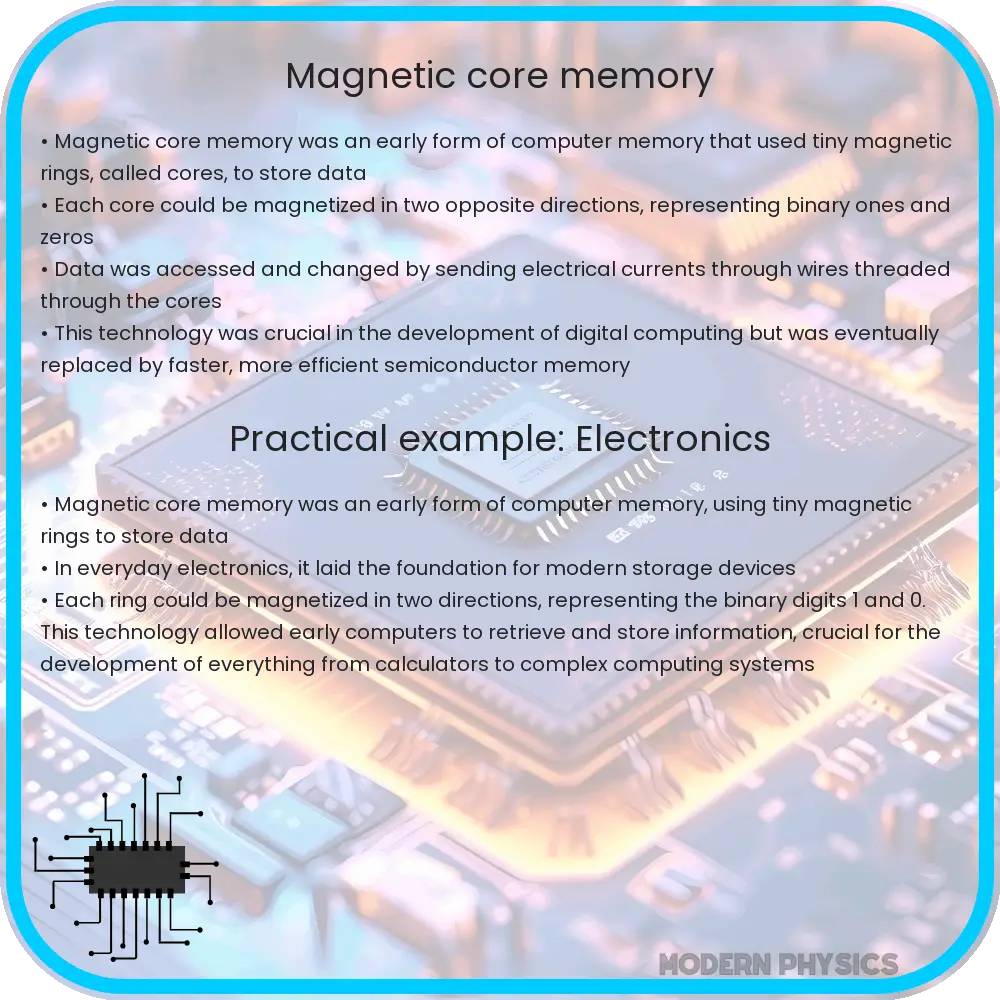Explore the history, operation, and impact of Magnetic Core Memory, from its data storage and reliability to its evolution and legacy in computing.

Magnetic Core Memory: An Overview of Data Storage, Speed, and Reliability
Magnetic core memory, a form of non-volatile random access memory (RAM), was a pivotal technology in the development of early computers. This article delves into the principles of magnetic core memory, examining its data storage mechanisms, speed of operation, and reliability. We’ll explore how this technology, despite being largely obsolete today, laid the groundwork for modern data storage solutions.
The Fundamentals of Magnetic Core Memory
At the heart of magnetic core memory lies an array of tiny magnetic rings called cores. Each core, made of a ferromagnetic material, can store a single bit of information. The cores are threaded with wires through which electrical currents pass, magnetizing the cores in one of two directions to represent binary ‘1’ or ‘0’. This arrangement enabled both the storage and retrieval of data.
How Magnetic Core Memory Stores Data
The unique feature of magnetic core memory is its non-volatility. Data stored in the cores remains intact even when the power is turned off, a significant advantage over earlier volatile memory systems. The process of writing data involves sending a current through the selected core’s wire, inducing a magnetic field that sets the core’s orientation. Reading data, on the other hand, is slightly more complex. It involves sending a current through the core to detect its orientation, which is then reset to its default state. This destructive read process requires immediate rewriting of the data just read.
Speed and Efficiency of Magnetic Core Memory
While magnetic core memory was significantly faster than its predecessors, its access times were in the order of microseconds—a far cry from the nanosecond speeds of today’s RAM technologies. The serial access nature of core memory also limited its speed. However, for its time, it was a revolutionary advancement, allowing for quicker and more efficient computing operations.
Reliability and Durability
One of the standout features of magnetic core memory was its reliability. The cores were highly resistant to environmental factors such as temperature changes and radiation, making them ideal for use in early space missions. Furthermore, the absence of moving parts reduced wear and tear, contributing to the memory’s longevity. This robustness was a significant step forward in data storage technology, setting the stage for the development of more advanced and reliable memory systems.
In the following sections, we’ll further explore the impact of magnetic core memory on modern computing, including its eventual obsolescence and the transition to newer forms of data storage.
The Legacy and Obsolescence of Magnetic Core Memory
Magnetic core memory served as a crucial stepping stone in the evolution of digital storage. By the 1970s, however, it began to fall out of favor, primarily due to the advent of semiconductor memory technologies. Semiconductor RAM, such as Dynamic RAM (DRAM) and Static RAM (SRAM), offered faster access times, greater density, and lower costs. As the size of computers shrank and their capabilities expanded, the bulky and relatively slow magnetic core memory became obsolete. Despite this, its fundamental principles influenced the development of later memory technologies.
Transition to Modern Memory Technologies
The shift from magnetic core memory to semiconductor-based memory marked a significant milestone in computing history. Semiconductor memories leveraged silicon-based technology to miniaturize components, leading to a dramatic increase in memory capacity and speed. This transition was pivotal in enabling the development of personal computers and sophisticated data processing systems, which required compact, efficient, and high-speed memory.
Another notable development was the advent of non-volatile semiconductor memory, like flash memory. Unlike magnetic core memory, flash memory allows for greater data density and faster access speeds without the need for a constant power supply to retain data. This advancement has been integral in the proliferation of portable electronic devices such as smartphones, tablets, and USB drives.
The Continuing Influence of Magnetic Core Memory
Despite its obsolescence, the legacy of magnetic core memory persists in modern computing. Its concepts of non-volatility and robustness have continued to be desirable traits in memory technology. Moreover, the understanding gained from developing and optimizing magnetic core memory has been instrumental in advancing current memory solutions, both in terms of hardware design and data storage algorithms.
Conclusion
Magnetic core memory, a once-revolutionary technology, set the stage for the rapid advancement of data storage technologies. Its impact is still felt in the principles it introduced, which continue to influence modern memory designs. The evolution from magnetic core memory to semiconductor memory underscores the dynamic nature of technology, where each innovation builds upon the past to pave the way for future advancements. As we continue to witness exponential growth in data generation and processing, the lessons learned from magnetic core memory remain relevant, guiding us towards more efficient, reliable, and faster data storage solutions.
